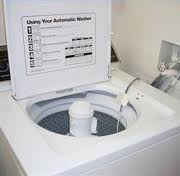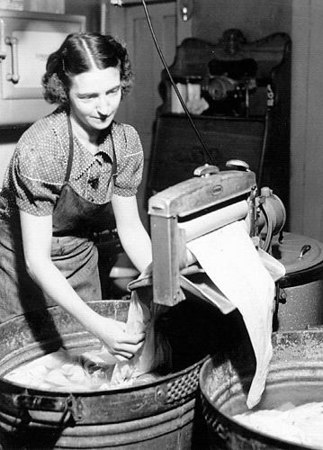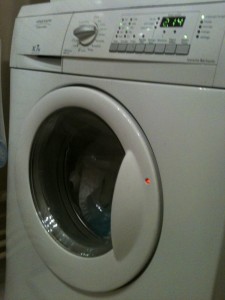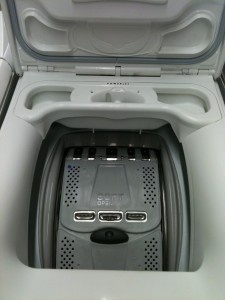 I grew up in North Queensland with one of those enormous top loading agitator washing machines that could wash huge loads in record time. We had a drip dry cycle which meant that the machine stopped after the last rinse and you could remove whatever you wanted, such as a drip-dry shirt, drain it on the draining board over the huge aluminium sink next to the machine, put it on a hanger and then hang it up under the house (our house was on stilts), dripping water over the concrete floor and yourself in the process. All of which was of no importance because the water had disappeared within an hour. You didn’t even get your shoes wet because you were bare foot anyway.
I grew up in North Queensland with one of those enormous top loading agitator washing machines that could wash huge loads in record time. We had a drip dry cycle which meant that the machine stopped after the last rinse and you could remove whatever you wanted, such as a drip-dry shirt, drain it on the draining board over the huge aluminium sink next to the machine, put it on a hanger and then hang it up under the house (our house was on stilts), dripping water over the concrete floor and yourself in the process. All of which was of no importance because the water had disappeared within an hour. You didn’t even get your shoes wet because you were bare foot anyway.

When we went on holidays to the Island, we stayed in Kooyang Flats which had a laundry down the back with a wringer machine. My sister and I were coopted into helping Mum with the washing. We loved turning the wringer and it was really quite a game, provided it didn’t last too long. Except for Mum of course. She must have hated it! Back breaking work for the woman who actually had to wash clothes for six people when she was on holiday, knowing that her huge agitator machine was sitting idle at home.
As I told you in a recent post, my experience with washing machines when I moved to France was somewhat different. Initially, I just used a laundromat. Speed Queens are used worldwide I’ve discovered. My first machine was a front loader tumble machine and I’ve never had anything else. It was in the kitchen though. I was horrified the first time I saw a washing machine next to someone’s fridge. There’s no real reason it shouldn’t be there, but it seemed strange. There are three basic reasons for this: practically no one in an apartment has a laundry room, the bathroom’s usually too small and you need a water connection.
 I always made sure I washed the clothes when Leonardo was awake because he used to sit mesmerised in front of the machine the whole time. We didn’t have a TV then. He’s always been mechanically minded. I like to think that I was partly responsible for that. If you’ve ever used one of those machines in France, you’ve probably wondered why the cycles are so long. My normal 40° cycle is 1 hour 17 minutes (my current machine has an electronic display) and the 60° cycle is 2 hours 15 minutes. Well, the reason is very simple even though it took me ages to discover it. They are all connected to a cold water supply so they have to heat up the water which obviously takes time.
I always made sure I washed the clothes when Leonardo was awake because he used to sit mesmerised in front of the machine the whole time. We didn’t have a TV then. He’s always been mechanically minded. I like to think that I was partly responsible for that. If you’ve ever used one of those machines in France, you’ve probably wondered why the cycles are so long. My normal 40° cycle is 1 hour 17 minutes (my current machine has an electronic display) and the 60° cycle is 2 hours 15 minutes. Well, the reason is very simple even though it took me ages to discover it. They are all connected to a cold water supply so they have to heat up the water which obviously takes time.
When my parents used come to my place on holidays in the winter (I was living in a house in the suburbs of Paris at that time with a sort of back veranda next to the kitchen that had very handy lines that I used during the summer months), they would insist on drip drying their clothes. The only thing they didn’t seem to be able to quite comprehend was that, number one, it was cold outside which meant that it would take days for the clothes to dry, and number two, the dripping water didn’t magically disappear the way it did in North Queensland. I didn’t have any drip-dry clothes myself.
 But there are other types of washing machines in France that I have experienced when on holidays in the country. They are top-loading tumble machines. Inside, there is a drum that revolves clockwise from the back to the front of the machine which means that the drum has to be tightly closed or the clothes will fall out. It comes with a unique opening/closing system where you have to match up some catches that are not easy to identify, then press on a not-always-obvious button. Of course few people really know how to manoeuvre the closing system and the opening has to be in the right place for you to do so. When the machine stops, the opening is usually at the bottom of the machine. Then as you take the clothes out, you can be absolutely sure that a baby sock will slip down the side of the drum, unbeknown to you, and cause the mechanism to seize up next time the machine is used. This is not necessarily your baby sock of course. You may just happen to be the next guest. For a long time, these machines were incomprehensibly the most popular in France. They still are to a certain extent because you can get ones that are 40 cm wide instead of the usual 60, a big boon in small bathrooms and kitchens. N’est-ce pas Leonardo?
But there are other types of washing machines in France that I have experienced when on holidays in the country. They are top-loading tumble machines. Inside, there is a drum that revolves clockwise from the back to the front of the machine which means that the drum has to be tightly closed or the clothes will fall out. It comes with a unique opening/closing system where you have to match up some catches that are not easy to identify, then press on a not-always-obvious button. Of course few people really know how to manoeuvre the closing system and the opening has to be in the right place for you to do so. When the machine stops, the opening is usually at the bottom of the machine. Then as you take the clothes out, you can be absolutely sure that a baby sock will slip down the side of the drum, unbeknown to you, and cause the mechanism to seize up next time the machine is used. This is not necessarily your baby sock of course. You may just happen to be the next guest. For a long time, these machines were incomprehensibly the most popular in France. They still are to a certain extent because you can get ones that are 40 cm wide instead of the usual 60, a big boon in small bathrooms and kitchens. N’est-ce pas Leonardo?
Don’t forget to subscribe to new posts – that way you’ll get them directly on your smart phone or in your mail box! And I love to hear your comments!





A few years ago when staying with a French friend I decided to tackle my washing in his top-loading tumble dryer. He couldn’t stop laughing when he found me trying to open the little plastic sachet of laundry liquid (per link below). How was I supposed to know that the plastic dissolved in the wash?
The other laundry related product I first discovered in France were the little sheets (about the size of a tissue) that you put in the wash to absorb any colours that run. They certainly made life much easier for me when I was doing an extended homestay and was only allowed to do one load of washing per week. They probably existed at that time in other Western countries but certainly not in Australia.
Link to image of the sachets: http://1.bp.blogspot.com/-i56Wit7w_pc/Twa0z0F_v5I/AAAAAAAAAZo/kHf1SSv41kI/s200/dosette-lessive-341407.jpg
Hi, I love that story about the sachets! They have sachets, but with powder inside, for the dishwasher. I’ll have to remember to warn my house exchange guests! I’ve never heart about the sheets to absorb colours that run. They sound wonderful and must be very useful when you only have a small load of mixed clothes.
I love hearing about everyone’s washing machine stories. So many expats have such hilarious and interesting experiences. It’s funny that something that I never thought about while living in America is such a piece of conversation now! Here are my thoughts:
http://manandwomaninparis.blogspot.com/2011/11/lady-lancelot-of-laundry.html
-Kristen
Welcome Kristen and thanks for sharing! I’m delighted to learn I’m not the only one with laundry problems in France. Of course, one thing people rarely realise is that a 5 kg washing load means TWO drying loads or more because you can only dry 2 kg at a time in the same size machine so you have to take have the wash out. I’ll have remember to tell my home exchange visitors that! And, of course, as your post explains, not all machines dry clothes as well.
Hi there ,
That is quite stange world , my name is ali , i have been living in sydney for 2 years , today helping my wife in laundry , just being couries about washong machine options and asked her , what is drip dry ? She did not know too, so googled it and end up in your blog aussie in france that .
I really like australia , i really do and kind of feeling the same as you in mayter of living an another country .
Wish all the best for you
Hello Ali and welcome to Aussie in France. I’m so glad you like my blog. I think being a foreigner in any country, even if you really like living there, has its difficult (and sometimes funny!) moments. I hope Australia will continue to treat you well. Just in case you didn’t get a satisfactory answer to “Drip dry”, it means that when you take the clothes out of the machine (usually shirts and dresses), you put them directly on a clothes hanger so that the remaining water will drip off and the clothes won’t need ironing when they are dry. It is useful in Australia where you can usually hang your clothes outdoors but not in France where we usually have to hang them inside! You may see “drip dry” written on certain shirts when you buy them, meaning that they don’t need ironing if you use the drip dry cycle on the machine. Good luck!
Hi all – I am an aussie living in France – I am looking for a top loader like we have in australia. Do they exist here in France? With the normal tub? I don’t like that I cannot stop the machine to put extra things in or take things out I want to drip dry.
Any ideas?
My apologies for taking so long to answer but I didn’t see your comment. I have never seen a top loader like the ones in Australia, but there is a type of machine that you can open while during the cycle. It has a drum inside. Darty sells them : https://www.darty.com/nav/achat/gros_electromenager/lave-linge/lave_linge_ouverture_dessus/index.html. Hope that helps!